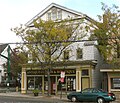Westville Village Historic District | |
 Hotel Edgewood (1913), 882-888 Whalley Ave. | |
| Location | Roughly along Blake St. and Whalley Ave. (original) 827 Whalley Ave. (increase), New Haven, Connecticut |
|---|---|
| Coordinates | 41°19′50″N73°10′20″W / 41.33056°N 73.17222°W |
| Area | 22 acres (8.9 ha) (original) and less than one acre (increase) |
| Architect | multiple |
| Architectural style | Federal, Greek Revival, et al. (original); Early Commercial (increase) |
| NRHP reference No. | 02001727 (original) 06000954 [1] (increase) |
| Significant dates | |
| Added to NRHP | January 23, 2003 |
| Boundary increase | October 25, 2006 |
Westville Village Historic District is a historic district representing most of the commercial center of the Westville neighborhood of New Haven, Connecticut. This center developed in the 19th century as an industrial mill village distinct from the city center, and retains many architectural features of that period. The district was listed on the National Register of Historic Places in 2003, and its boundaries were increased slightly in 2006. [1]







